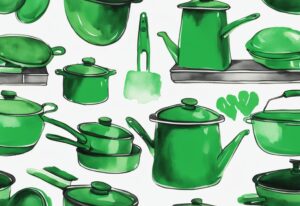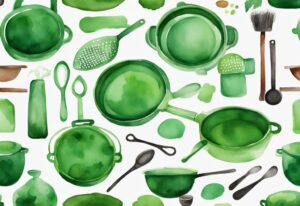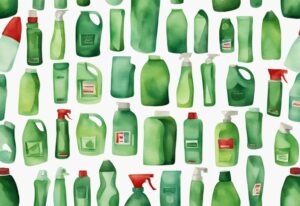Is Native Bad For Your Hair? Uncover Truth & Expert Solutions
As a self-confessed non-toxic living advocate, I’ve heard the buzz around Native hair products. You’re here because you’ve heard the whispers too: is Native bad for your hair? Let’s face this question head-on, as it’s time we reveal the truths that lie beneath all that lush, eco-friendly packaging.
This article unravels the mystery behind Native’s natural and cruelty-free declarations. We’ll scrutinize each component and consider real user experiences to paint a holistic picture. Are these hair care solutions pure friend or subtle foe?
Staying ahead means understanding what we’re introducing to our bodies. So let’s dig deep to help you make conscious, health-oriented choices. Because isn’t that what non-toxic living is all about? Step into this revealing journey with me, and let’s decipher the Native hair care saga together!
Unveiling Native Hair Care Products: Are They Safe?
When it comes to choosing hair care products, safety and ingredient integrity are paramount concerns. Native shampoo stands out by offering formulations that are natural, vegan, and cruelty-free. These shampoos avoid detrimental chemicals like sulfates, parabens, silicones, and phthalates, which are known to cause potential hair damage with prolonged use. The absence of these harmful substances puts many consumers at ease, knowing their hair is less likely to suffer from the adverse effects that can arise from harsh chemical treatments, especially when considering the mixed messages about ingredients like sulfates, silicones, and phthalates that can compromise hair health. For more information on these ingredients, check out this [insightful article](https://innersensebeauty.com/blogs/blog/truth-about-sulfates-silicones-and-phthalates?srsltid=AfmBOoqUWOXPrJr232lbNufg8VS1PQhbq66yQSS-1x0XC16clkAzWYsi).
An attractive feature of Native shampoo is its limited ingredient list. This minimalist approach not only simplifies the product but also ensures that users are less exposed to various unnecessary additives. However, while the concise ingredient list is generally appreciated, it has raised some concerns over the transparency of the fragrances used. Users want to be assured about the safety and nature of these scents, especially given the potential for allergic reactions and sensitivities.
Examining the Claims of Native Shampoo and Conditioner
Native’s marketing emphasizes that their shampoos and conditioners result in softer, shinier hair. This claim targets individuals seeking improvements in their hair’s texture and visual appeal. The exclusion of harsh chemicals from their recipes serves as a noteworthy selling point, differentiating Native products from many conventional alternatives.
However, it’s important to note that some reviews contradict these positive claims. A few users have reported experiencing greasiness and an unpleasant scent after using Native products. These issues suggest that while the overall formulation might be beneficial for some, it may not be universally ideal. The mixed feedback underscores the importance of piloting the product to see how it interacts with individual hair types and preferences.
A Closer Look at the Ingredients in Native Products
The formulation of Native hair care products includes a variety of beneficial ingredients. Coconut oil, shea butter, tea tree oil, charcoal, peppermint oil, and aloe vera are among the key components. These ingredients are celebrated for their moisturizing, nourishing, and soothing properties. Additionally, the inclusion of such naturally derived substances makes Native an eco-friendly choice, especially for those with sensitive scalps.
Nonetheless, the issue of fragrance transparency cannot be overlooked. While Native products are fundamentally composed of beneficial ingredients, the undisclosed nature of their fragrances raises questions. For users with sensitive skin, potential allergies, or aversions, not knowing the full composition can be troubling. This lack of transparency creates a slight dilemma, as the risk of irritation or adverse reactions from unknown fragrance chemicals remains.
The Good, The Bad: Breaking Down the Ingredients in Native Shampoo
Beneficial and Natural Ingredients
Native Shampoo has been catching a lot of attention lately for its selection of natural ingredients. Take coconut oil, for instance. It’s famed for its moisturizing properties, ensuring your hair feels smooth and looks radiant. Alongside it, there’s shea butter, which offers nourishing hydration, essential for maintaining hair’s strength and elasticity.
Then we have tea tree oil, a favorite for promoting scalp health and tackling issues like dryness and dandruff. Charcoal serves as a gentle cleanser, effectively removing impurities from the scalp without stealing its natural oils. Not to forget the refreshing touch of peppermint oil, which stimulates the scalp and might even aid in promoting hair growth.

And let’s not overlook aloe vera. Its soothing and hydrating properties are especially beneficial for a healthy scalp. This thoughtful combination of ingredients makes Native Shampoo an appealing choice for anyone looking for a natural hair care solution.
Potentially Detrimental Ingredients: Are there any?
But even with all these positives, there are some ingredients in Native Shampoo that might cause concern. Sodium benzoate, a widely used preservative, could be an irritant for sensitive scalps. It’s generally safe in small amounts, but if you have sensitive skin, it could be a problem.
And then there’s 1,2 Hexanediol. While it helps in stabilizing formulations, it’s considered potentially toxic and harmful to the environment. So, when you’re weighing your options and wondering, is Native bad for your hair?, it’s worth considering these factors. If you’re also curious about other products and wondering, is Caraway really non-toxic, make sure to check the ingredients and environmental impact.
____
Fragrance in Native Products: Cause for Concern?
Fragrances in hair care products can indeed be a double-edged sword, and Native Shampoo is no exception. These scents can make your hair-washing experience pleasant, but there’s an issue with transparency. Often, the specific chemicals used in these fragrances aren’t disclosed, potentially leading to allergic reactions or skin irritation.
There’s also the matter of certain fragrance chemicals being linked to more serious health concerns, although there’s no concrete evidence tying them to hair loss. If you have sensitive skin or allergies, these potential risks might prompt you to question: is Native bad for your hair?
In summary, while Native Shampoo comes with several beneficial ingredients, its potentially harmful preservatives and undisclosed fragrance components should make you pause and think about your own sensitivities and what suits you best.
Native and Its Effects on Various Hair Types
Impact on Thick and Frizzy Hair
Native shampoos and conditioners have often been a lifesaver for those of us wrestling with thick and frizzy hair. Natural moisturizing agents like coconut oil and shea butter offer deep hydration and nourishment. They work wonders to tame frizz, giving hair a smoother, more manageable look.
These ingredients work together to coat each hair strand, sealing in moisture and reducing the effects of humidity—an all-too-common trigger for frizz. With regular use, many people, including myself, have noticed a significant reduction in frizz and an overall improvement in hair texture and health. So, if you’re pondering, “is native bad for your hair,” those with thick and frizzy hair tend to find it quite beneficial.
Native on Thin and Oily Hair: Benefits and Drawbacks
When it comes to thin, oily hair, experiences with Native have been a mixed bag. Some appreciate the formula for its gentle cleansing without stripping natural oils, yet others struggle with increased oiliness and greasiness.
The oils and butters that do miracles for thick hair can be too heavy for thinner strands, causing them to weigh down and making the scalp feel oilier. This hair type might find the product a bit too nourishing, resulting in an undesirable greasy look. So, when the question arises, “is native bad for your hair,” individuals with thin, oily hair may need to use the product sparingly or alternate with a lighter formula to strike a balance.
Is it Safe for Color-Treated Hair?
Native shampoos and conditioners generally sit well with color-treated hair, thanks to their sulfate-free and gentle formulations. Sulfates can easily strip the color from dyed hair, causing it to fade, but Native’s omission of these harsh chemicals helps in maintaining color longevity.
However, it’s wise to test any new product on a small section of your color-treated hair first. This simple step ensures there are no adverse reactions and gives peace of mind that the product won’t negatively impact your hair dye. For those curious, “is native bad for your hair” when it comes to color treatments, the answer tends to be favorable, as long as you conduct a patch test to ensure compatibility.
Effects of Using Native in Hard Water Conditions
Dealing with hard water can be a real struggle, leading to dryness and dullness. But Native shampoo and conditioner seem to perform admirably in such conditions. Ingredients like tea tree oil and aloe vera provide extra hydration and soothe the scalp.
Many have reported their hair feeling softer and looking shinier despite the harsh effects of hard water. So, if you’re wondering, “is native bad for your hair” in hard water conditions, the general consensus leans towards it being a good choice, helping improve your hair’s look and feel even in challenging environments.

Digging into User Issues with Native Hair Care Products
Exploring common user concerns about Native hair care products, we uncover various experiences that shed light on potential issues and how to address them effectively.
Reports on Oily Hair Issues
Some users have found that Native shampoo, infused with natural oils and salts, can leave their hair feeling oilier than expected. While these ingredients are meant to nourish, they may create excess oiliness for certain hair types. Transitioning from sulfate-based shampoos to a sulfate-free option like Native often involves an adjustment period. During this phase, your scalp might produce more oil as it adapts. Reducing how often you shampoo or the amount used can help manage this increased oiliness.
Concerns over Hair Loss: Is Native to Blame?
Many wonder, “is Native bad for your hair,” especially regarding hair loss. As of now, there is no evidence to suggest a direct link between Native shampoo and hair loss. Hair loss could be related to personal sensitivities to specific ingredients, particularly fragrances. While Native strives to create gentle formulations, everyone’s skin is different. If you have known allergies or sensitivities, proceed with care. Consulting a dermatologist can provide insights tailored to your needs.
Allergic Reactions: Known Instances and How to Handle Them
Though crafted with natural and gentle ingredients, some users have reported allergic reactions to Native shampoo, such as redness, itching, and scalp irritation. Fragrance ingredients can sometimes trigger sensitivities even if they are not fully disclosed. A patch test before widespread use can help prevent severe reactions. Should you experience any intense reaction, stop using the product immediately and consult a dermatologist. Identifying specific allergens early can help keep your scalp healthy and comfortable.
Native Shampoo vs Other Natural Alternatives: Which is Better?
When weighing the pros and cons of Native Shampoo against other natural alternatives, there are several crucial factors to consider. This helps ensure a well-rounded perspective on what truly benefits your hair.
Comparing Ingredients: Are Key Differences Beneficial?
Native Shampoo has attracted a lot of attention for its minimalist approach, steering clear of numerous harsh chemicals that often sneak their way into other hair care products. Sulfates, parabens, silicones, and phthalates are all on Native’s exclusion list. Instead, Native focuses on incorporating fewer ingredients, frequently drawing from natural and vegan options like coconut oil, shea butter, and tea tree oil.
But despite these positives, there’s an ongoing issue with transparency around the fragrances used in Native products. While many people love the concise ingredient list, the lack of full disclosure about fragrance components creates skepticism, especially for those with sensitive skin or allergies. So, if you’re wondering, “is Native bad for your hair?” it really comes down to balancing the product’s natural, eco-friendly elements with the potential reactions from undisclosed ingredients.
User Satisfaction: Native vs Other Brands
Choosing between Native and other natural hair care brands often boils down to personal priorities and experiences. Reviews of Native Shampoo are quite mixed. Many users appreciate its gentleness on the scalp and eco-friendly formulation. The inclusion of natural ingredients and the cruelty-free stance align with the values of eco-conscious consumers.
However, not all feedback is positive. Some users face issues like hair greasiness and dissatisfaction with the product’s scent. Compared to other natural brands, Native’s higher price point and concerns over fragrance often sway opinions. While Native excels in certain areas, its differences from other brands mean it might not be suitable for everyone.
The question, “is Native bad for your hair?” is subjective and deeply influenced by individual hair types and sensitivities. Conducting a patch test and considering your personal hair needs is crucial before fully integrating Native Shampoo into your daily routine.
FAQs: Addressing Common Queries about Native Hair Care Products
Is Native Shampoo Safe for Sensitive Scalps?
Yes, it is generally safe and gentle on sensitive scalps. The shampoo incorporates natural, soothing ingredients aimed at minimizing irritation. However, it’s always recommended to perform a patch test first to ensure no adverse reactions occur.

Can Native Shampoo Cause Hair Loss?
No, there are no proven links to hair loss. Certain users might experience concerns due to ingredient sensitivities, particularly to fragrance. Nonetheless, overall, Native shampoo does not contribute to hair thinning or loss.
What Can be Done if Hair Turns Greasy After Using Native Shampoo?
An adjustment period is common when transitioning to sulfate-free shampoos like Native. To combat greasiness, try reducing application frequency and ensure thorough rinsing. Additionally, consider using a smaller amount of product to avoid residue buildup.
Are All Ingredients in Native Shampoo Natural?
While the majority of Native shampoo ingredients are natural, some preservatives and fragrances lack full transparency. This can raise concerns for users seeking completely natural products. Always review ingredient lists carefully to align with your preferences.
Is Native Shampoo Suitable for Color Treated Hair?
Yes, Native shampoo is generally suitable for color-treated hair due to its gentle formulation. To ensure compatibility and prevent any possible adverse effects, it’s advisable to test the shampoo on a small section of hair first.
Finding Your Verdict: Is Native Bad for Your Hair?
Native hair care products have garnered attention for their commitment to using natural, vegan, and cruelty-free ingredients. One of the major appeals is that they are sulfate-free, which means they avoid one of the most commonly cited harmful chemicals in hair care. Sulfates can strip natural oils from the scalp, causing dryness and irritation. By excluding such ingredients, Native shampoo and conditioner position themselves as safer options for maintaining the natural health of your hair and scalp.
Despite these benefits, some users have raised concerns regarding the transparency of the fragrance ingredients in Native products. Fragrances can often include a mix of chemicals, some of which may cause allergic reactions or irritation, especially for those with sensitive skin. The lack of full disclosure about these fragrance components creates a level of uncertainty among potential users, leading to questions about the overall safety of the product. However, it’s important to note that these concerns are similar to those raised about many personal care products that contain fragrance.
User reviews for Native hair care products are varied, reflecting a wide range of individual experiences. People with different hair types and sensitivities report diverse outcomes. For a detailed comparison on popular skin care options, check out our article on Carmex vs Vaseline. For some, the products work remarkably well, leaving their hair softer and shinier. Others, however, have noted issues such as increased greasiness or an unpleasant scent, particularly during the initial transition period which is common when switching to sulfate-free products. Users with thin or oily hair may find the formula too heavy, while those with thick or frizzy hair might appreciate the added moisture and smoothness.
To determine whether Native is bad for your hair, it’s crucial to consider your unique hair type and needs. Conducting a patch test is a sensible first step; apply a small amount of the product to a section of your hair to observe any adverse reactions. For those with color-treated hair, Native products are generally safe, though testing on a small section first can help prevent unwanted effects. The gentleness of the ingredients suggests a lower risk of stripping color compared to more abrasive shampoos.
Ultimately, Native hair care products offer a gentler, eco-friendly choice for those looking to avoid harsh chemicals. Given the mixed reviews and concerns about ingredient transparency, it’s essential to assess how your hair and scalp respond to the product. Keep in mind that finding the right hair care routine is often a matter of personal trial and adjustment. By carefully evaluating Native products against your own hair care requirements, you can make an informed decision about their suitability for your hair.
Hi, I’m Olivia Green, the voice behind nontoxicways.com. I’m passionate about helping you make the shift to a healthier, non-toxic lifestyle without feeling overwhelmed. I love sharing my personal journey, from small changes to big transformations, along with practical tips that make it all feel doable. My goal is to inspire and guide you toward a lifestyle that benefits both your well-being and the planet. Let’s take this journey together, one simple step at a time!














Post Comment